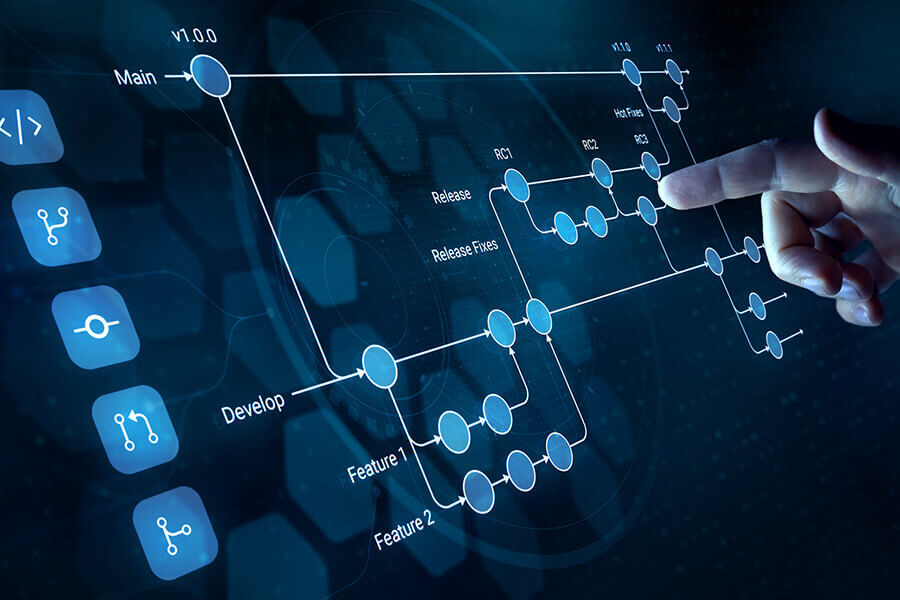LLMOps vs MLOps: Key Distinctions in AI Operations Management
Machine learning operations have evolved beyond traditional models to accommodate the unique challenges of large language models. While MLOps provides the foundation for managing conventional machine learning workflows, the emergence of powerful language models, such as GPT and Claude, has created new operational complexities that require specialized approaches.
LLMOps is essentially MLOps explicitly tailored for large language models, addressing the distinct challenges posed by their scale, computational requirements, and deployment patterns. While traditional MLOps handles structured and unstructured data, LLMOps extends the discipline to address text-generation challenges like context windows, token limits, hallucination reduction, and safety assurance.
Understanding these differences becomes crucial as organizations increasingly adopt generative AI applications alongside traditional machine learning systems. The operational frameworks, tooling requirements, and best practices vary significantly between managing a fraud detection model and deploying a conversational AI system, making it essential to recognize when each approach applies.
Key Differences Between LLMOps and MLOps
LLMOps introduces specialized workflows for prompt management and token-level monitoring, while MLOps focuses on traditional feature engineering and model training pipelines. The operational challenges shift from data preprocessing concerns to prompt injection vulnerabilities and expensive inference costs.
Model Lifecycle and Workflow
MLOps follows a traditional pipeline where teams collect training data, perform feature engineering, train models from scratch, and deploy them. The workflow emphasizes data preprocessing, model selection, and iterative training cycles.
LLMOps operates differently by starting with pre-trained models, such as GPT or Llama-3. Teams focus on fine-tuning pre-trained models rather than building them from scratch. This approach reduces training time but introduces new complexities.
In large language models, prompt engineering replaces traditional feature engineering. Instead of designing input features, practitioners craft and refine prompts to guide model behavior and achieve precise outputs. This shift fundamentally changes how models are developed and maintained—leading directly into the LLMOps approach, where teams work with powerful pre-trained models like GPT or Llama-3. Rather than building from scratch, they fine-tune these models for specific tasks, reducing training time but introducing new operational complexities.
LLMOps workflows incorporate retrieval-augmented generation (RAG) systems that combine external knowledge sources with generative AI capabilities. These systems require specialized data pipelines that differ significantly from standard ML pipelines.
The feedback loops in LLMOps often involve human reviewers evaluating the quality of generated text. This contrasts with MLOps, where automated metrics typically drive improvements in model performance.
Operational Challenges and Solutions
MLOps practitioners address model drift by monitoring input features and prediction accuracy. They track changes in data distribution and retrain models when performance degrades.
LLMOps faces unique security challenges, exceptionally prompt injection attacks where malicious inputs manipulate model behavior. Traditional MLOps security measures don’t address these language-specific vulnerabilities.
Cost management differs significantly between the two approaches. Large language models consume substantial computational resources during inference, making cost tracking essential for LLMOps implementations.
Prompt management systems are becoming critical infrastructure in LLMOps, requiring version control for prompts, A/B testing, and template management. MLOps doesn’t need the same infrastructure as traditional machine learning models.
LLMOps must handle complex data flows from multiple sources with varying formats. These models ingest diverse text data that requires specialized preprocessing, unlike structured data in conventional ML pipelines.
Traditional MLOps pipelines already manage unstructured data effectively, but LLMOps brings a new layer of complexity. Large language models require generation-specific operations, such as handling context windows, evaluating responses for accuracy and faithfulness, and applying safety filters to ensure reliable, responsible output.
Feedback and Monitoring Differences
MLOps monitoring focuses on numerical metrics like accuracy, precision, and recall. Teams track model performance through quantitative measures and automated alerting systems.
LLMOps can have token-level observability to understand how models process and generate text. This granular monitoring helps identify issues in language generation that traditional metrics cannot capture.
Human feedback integration plays a significant role in LLMOps through techniques such as reinforcement learning from human feedback (RLHF). This process requires specialized infrastructure to collect and incorporate human preferences into model behavior.
Response evaluation in LLMOps often involves subjective assessments of text quality, relevance, and safety. These evaluations require different methodologies than those used for objective performance metrics in traditional MLOps.
The iteration cycles in LLMOps frequently involve prompt adjustments rather than model retraining. This creates faster feedback loops but requires different monitoring approaches to track prompt performance over time.
Unique Components and Best Practices in LLMOps
LLMOps requires specialized pipeline architectures that handle vector databases and API services for efficient model serving. Organizations must implement robust resource optimization strategies while maintaining strict security and compliance standards throughout the LLM deployment lifecycle.
Pipeline Architecture and Data Management
The LLMOps pipeline architecture differs significantly from traditional MLOps by integrating vector databases and specialized API services. Vector databases enable efficient storage and retrieval of embeddings for context management and retrieval-augmented generation workflows.
Modern LLMOps pipelines incorporate AI gateways that manage multiple model endpoints and route requests based on performance metrics. These gateways handle load balancing across different LLM deployments and provide unified interfaces for various model-serving configurations.
CI/CD processes in LLMOps must accommodate unique requirements, such as prompt versioning and context validation. Configuration stores become critical for managing prompt templates, retrieval contexts, and model configurations across different deployment environments.
Key Pipeline Components:
- Vector database integration (Qdrant, Pinecone)
- AI gateway for request routing
- Prompt management systems
- Context retrieval mechanisms
- Specialized CI/CD workflows
Performance monitoring extends beyond traditional accuracy metrics to include response latency, token generation rates, and contextual relevance scores. Platforms like Weights & Biases provide specialized tracking for LLM-specific performance metrics throughout the inference pipeline.
Resource Optimization and Infrastructure
Computational resources for LLM deployment require careful optimization due to their massive scale and memory requirements. Organizations must implement dynamic scaling strategies that account for token processing rates and model size constraints during inference operations.
Resource management involves GPU memory optimization, batch processing configurations, and distributed serving architectures. LLM deployment strategies often employ model quantization and pruning techniques to minimize computational overhead while maintaining high performance quality.
Resource Optimization Strategies:
- Dynamic GPU allocation
- Memory-efficient serving configurations
- Batch processing optimization
- Model quantization techniques
- Distributed inference architectures
Scalability planning must address peak usage patterns and forecasted token consumption to ensure optimal performance. Infrastructure teams implement auto-scaling policies based on request queues, response times, and resource utilization metrics specific to language model workloads.
Performance monitoring tools track inference latency, throughput metrics, and resource utilization across distributed serving environments. DevOps teams establish alerting systems for GPU memory limits, token rate limits, and model availability issues.
Security, Compliance, and Ethics
Security and compliance frameworks in LLMOps address unique challenges around data privacy, model bias, and output filtering. Organizations implement content moderation systems that monitor generated text for inappropriate or harmful content in real-time.
Model governance structures ensure compliance with industry regulations and internal policies. Teams establish review processes for prompt engineering, dataset fine-tuning, and model version approvals before production deployment.
Security Best Practices:
- Input sanitization and validation
- Output content filtering
- Access control for model endpoints
- Audit logging for generated content
- Data privacy protection measures
Ethical considerations require continuous monitoring of model outputs for bias, fairness, and potential misuse. Organizations implement automated scanning systems that flag problematic generations and maintain human oversight for sensitive applications.
Compliance monitoring tracks data lineage, model provenance, and usage patterns to ensure compliance with regulatory requirements. Security teams establish incident response procedures for model failures, data breaches, and ethical violations specific to LLM operations.
Conclusion
As organizations expand their AI capabilities, recognizing the differences between MLOps and LLMOps becomes essential for long-term success. While MLOps remains critical for structured, predictive use cases, LLMOps introduces a specialized operational layer designed for the scale, unpredictability, and continuous adaptation of large language models. Treating the two as interchangeable overlooks the unique demands of generative AI and risks inefficiencies, higher costs, and potential vulnerabilities.
By embracing LLMOps as a distinct discipline, enterprises can unlock the full potential of language models while maintaining reliability, governance, and scalability. From monitoring hallucinations to managing massive computational workloads, LLMOps provides the frameworks and practices needed to operationalize generative AI responsibly.
Ultimately, the future of AI operations lies not in choosing between MLOps and LLMOps, but in knowing how to leverage each effectively. Organizations that build clear strategies for both will be better equipped to innovate, deliver value, and remain competitive in a rapidly evolving AI landscape.








